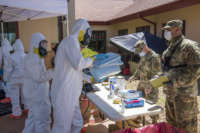
As the COVID-19 outbreak continues to sweep through the U.S., many have noticed the coupling of military and health. There’s been an ongoing conversation amongst oncologists for years about the use of war metaphors in cancer research and treatment. In fact, many public health concerns are framed in these terms — “war on drugs” or “war on poverty,” for example. It’s argued the use of these metaphors help make it easier for our society to better understand health. But herein lies a follow-up question: why?
These metaphors are not as unconscious as we’d think. Anthropologists have studied the ways immunological functioning is encased in war imagery. Emily Martin powerfully illustrates how our categorical and systemic understanding of immunology represents a police state. Invasions of foreign bodies and immunological cells coming to the defense mimic the kind of warfare we might see on TV. Here, scientific empiricism becomes a mere farce, and it is apparent many concepts are actually influenced by the larger socio-political sphere. Thus, the endless metaphorical wars begin to make more sense.
In a post-colonial world, militaries help secure borders and the interests of the global ruling class. Although always present, after September 11, there was a noted increase in the militarization of U.S. society as we moved to normalize the further militarization of police forces, the creation of new war technology and surveillance structures, justified under the guise of national security. The ongoing normalization of these frameworks has seeped into many facets of society, including health care. This past year, the co-option of military jargon to name health care workers as “frontline soldiers” thrusted them on a pedestal of heroism and honor. Moreover, National Guard soldiers were also deployed to assist with COVID-19 testing in predominantly working-class communities across several states when infection rates reached new heights in 2020.
While this conflation appears benign, its contradictions are relentless. For one, it functions to obfuscate a dire reality, presenting a facade of order and control. Where language tells us health care workers were frontline soldiers, reality tells us individuals were scapegoated and thrust into battles with little help or support from the ones handing out proverbial medals. Where language tells us vaccine rollouts — combatively coined “Operation Warp Speed” — will bring an end to our viral misery, reality also illustrates a patchy distribution scheme and a lack of political will displayed by our state to enact the structural change we actually need to remedy the larger socio-political issues that led to the spread of COVID-19.
The marriage of health and military is also an ironic endeavor. While the National Guard was deployed to help with COVID-19 testing across the nation, it was simultaneously deployed on behalf of the state to support local police forces in quelling Black Lives Matter protests. National Guard members stood protecting government property, intimidating members of the public with large guns in their hands, while local police tear-gassed the protesting crowds. It’s important to note many experts, including the American Thoracic Society, denounced the use of tear gas, specifically because of the increased ability for COVID-19 transmission with its use.
Furthermore, consider the countless images and videos circulated this past year of law enforcement gathering and handling crowds sans face masks, functioning in direct contradiction to Centers for Disease Control and Prevention guidelines and local state mandates. In addition, the rampant spread of COVID-19 in jails and prisons across the country was also linked to local authorities’ intransigence on offering prisoners proper protections and the inherent racism of our carceral system. Even budding concerns around safety protocols for those detained at Guantánamo Bay were inadvertently silenced by the state.
We must also consider the military’s hand in the surveillance of communities of color. From policies like Countering Violent Extremism programs, the Patriot Act and the monitoring of undocumented people by Immigration and Customs Enforcement, the consequences of these programs remain dire for communities of color across the country. We cannot ignore the harm potentially authorized by placing the responsibility of health care in the same institutions that rely on these dehumanizing structures.
Why are we so apt to allow the same institutions that harm and police our communities the room to conduct work that might serve to heal them? While the situation maintains complexity, there is no denying our compliance with this framework stems from society’s inability to imagine a world without violence, even in terms of health and healing. From the staunch hierarchies fostered by these frameworks that warrant health care workers and generationally marginalized members of our society disposable for the supposed greater good, to the larger contradictions present on a global scale, it’s evident the normalization of this framework confirms our desensitization to the cost of human life.
If we are to begin reimagining a new world, it must include the undoing of these frameworks. At a time where we need deep healing, it becomes evident the marriage of military and health serves more to protect the interests of the state and less of our communities. We must begin critically engaging with how we teach about health and illness and who we are deeming as the authority on these initiatives. The collision of warfare and health blurs the lines between humanity and violence; it dehumanizes and distorts. An institution designed to police and destroy will never be our salve. We must reimagine new systems of health and healing for ourselves and our future generations — ones that steer the structural change we need and don’t require endless human sacrifice nor offer our oppressors the title of humanitarian.
